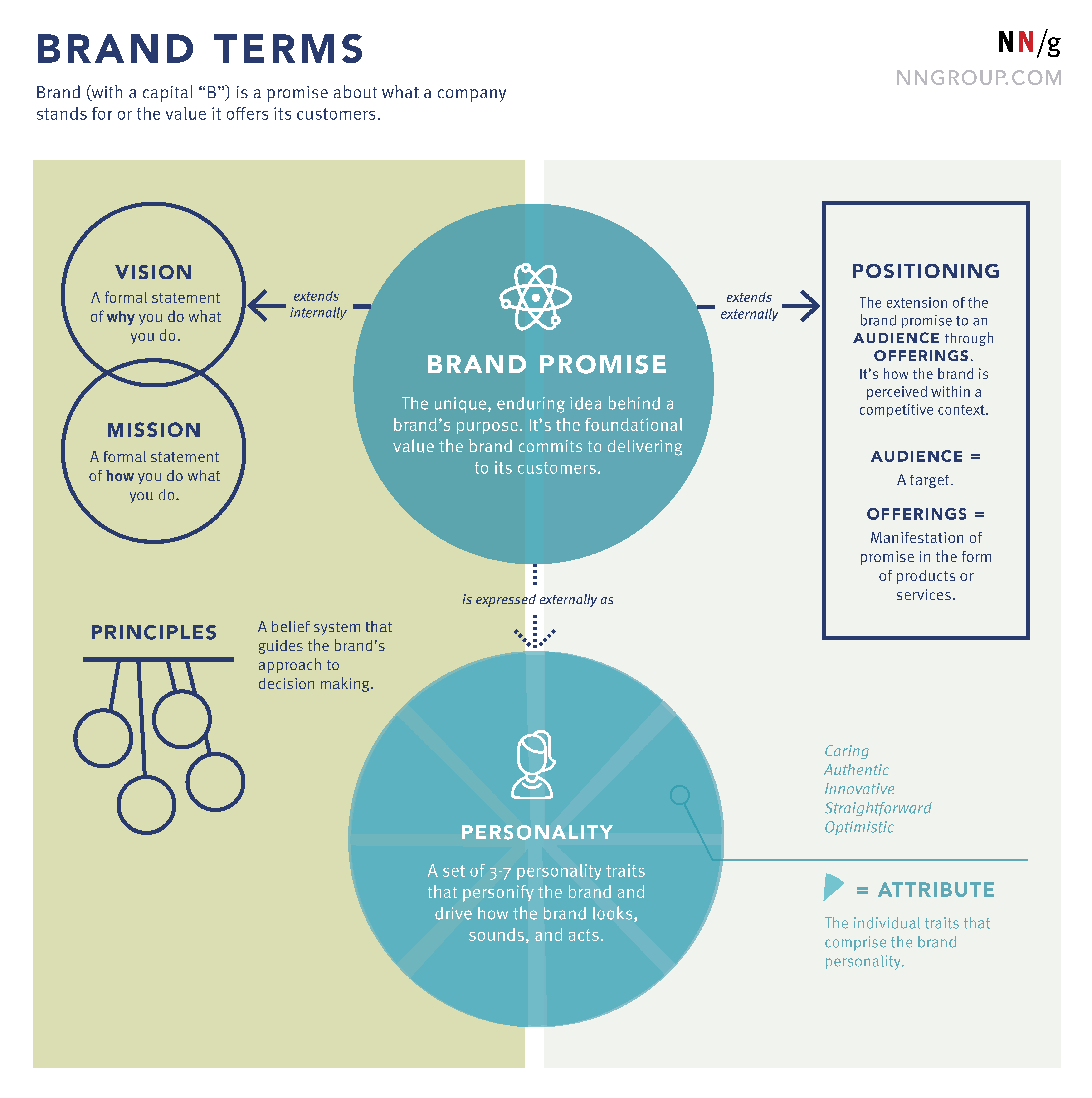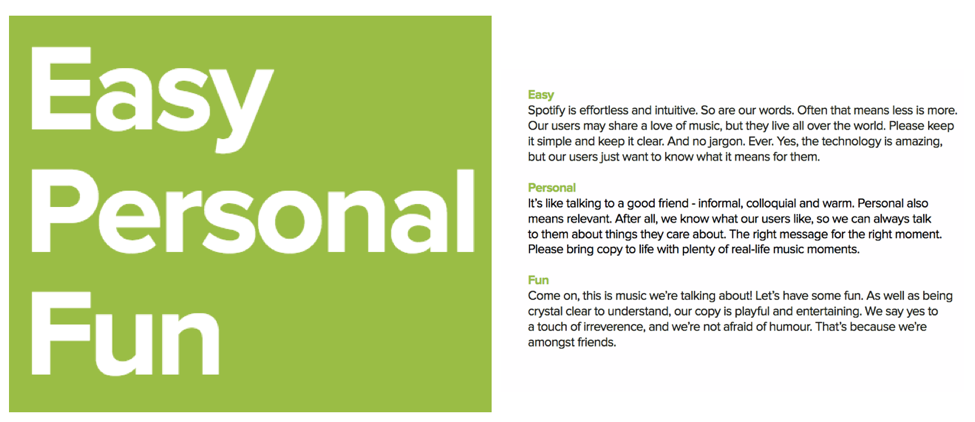Today, due to complex digital user experiences and two-way dialogues (e.g., social sharing and user-generated content) brand is a complex, multifaceted notion. The language used to refer to key brand concepts can be ambiguous and confusing, especially when it comes to those terms’ relationships to the user experience. Oftentimes, brand components are not clearly defined (and are even incompatible at times). In fact, the term “brand” itself is commonly misused to mean a product name, visual identity, or logo.
To provide clarity, we’ve compiled and defined a set of key brand terms, and provided some context to these elements’ roles in user-experience design. These definitions are intended to help organizations and designers establish a shared vocabulary and understanding when translating brand to user interactions.
What is Brand?
Let’s set the stage with a reiteration of our definition of brand vs. branding, two often confused concepts:
- Brand (with a capital “B”) is a promise about what a company stands for, or, the value it offers its customers. For example, a specific Brand could represent a promise that its associated products might be "healthy,” “sustainably made,” or "durable."
- Branding (with a lowercase “b”) is then defined as the controlled manifestation of the Brand’s identity through application of logo or other guidelines to advertising, communications, packaging, and so on.
With the first, more meaningful definition of Brand in mind, we’ve compiled and defined the concepts that comprise an organization’s brand framework—those concepts that must be defined and understood on a company-wide level in order for an organization to provide a consistent brand experience across channels. This is the kit of parts that an organization must articulate and document in order to have a solid brand foundation from which teams can make cohesive design decisions.
Components of a Brand Framework
There are six core elements of a brand framework that must be understood across teams in order for compartmentalized teams to effectively translate brand into consistent user interactions:
- Brand promise
- Brand personality
- Brand attributes
- Mission
- Vision
- Brand principles

(1) Brand Promise
Brand promise (also referred to as brand concept, meaning, or essence) is the unique, enduring idea behind a brand’s purpose. It’s the foundational value that the brand commits to delivering to its customers. Sometimes the brand promise is used as the tagline or slogan for a company, but not always.
Brand promise does not manifest in just one place in the user experience, but rather throughout the entire omnichannel experience. The brand promise drives all other factors, both internal and external — from company vision, mission, and principles to brand positioning, audience, and marketing.
The brand promise answers the question, “What is this company’s reason for being?” Some example brand promises are:
- Apple: Think different
- Fedex: The world on time
- Target: Expect more. Pay less.
- GE: Imagination at work
At first, brand promise in the context of UX may seem abstract. However, think about using brand promise as a metric. Before release, return to your stated promise and compare the experience. Is your brand fulfilling its promise to its users? If not, how can you use your role as a designer to bridge the gap between the intended brand promise and the reality of the user experience?
(2) Brand Personality
Brand personality is a set of well-defined traits that personify the brand. This personality informs everything from product or service design to the development of visual systems and communication with customers. A well-defined brand personality answers the questions: “If the brand were a person or character, what would it be like? How would it act in certain situations?”
Sometimes, brands go so far as to create a mascot or brand persona to represent their personality, such as MailChimp’s Freddie Von Chimpenheimer IV. In this case, the brand persona serves double duty as a brand mascot, but that is not always the case.

In UX, brand personality can be used to drive design decisions about specific interactions, visuals, and copy. If a brand is playful or funny, animations or page loads should somehow indicate such. If a brand is straight-forward and serious, the copy used would err on the side of formal and professional.
(3) Brand Attributes
Brand attributes are the individual characteristics, or personality traits, that make up a brand personality.
For example, Walmart lists its brand attributes as:
- Caring
- Authentic
- Innovative
- Straightforward
- Optimistic
Together, this set comprises Walmart’s brand personality.

Together, the brand attributes help an organization drive design decisions and create user interactions — whether human-to-human or human-to-machine — that are aligned to the brand personality.
Typically, brands have a set of 3–7 brand attributes, which are well-defined within the context of the organization. In both the Walmart example above and the Spotify example below, the organization has taken time to provide specific definitions for what these potentially vague terms mean for design and brand experience. With this additional context, a set of brand attributes becomes a ready-to-use litmus test for designers. For example, when designing a user flow or even email copy, Spotify designers or writers can ask themselves: “Is this experience easy, personal and fun? Does it embody our brand attributes?”

(4) Brand Vision and (5) Mission
Brand vision and mission are formal statements that help the brand express its promise in more tactical ways. The brand vision expresses why the company does what it does, and the brand mission expresses how the company attempts to deliver on that vision. In other words, the vision is the company’s answer to the question: “If our brand existed in its most ideal form, what would the world look like?” In turn, the mission answers the question: “How will we get there?”
For example, as noted in its brand book, Sesame Street’s vision is “a better world for us all.” It aims to achieve this vision through its mission: “to help all children reach their highest potential.” Sesame Street acclaims that in order to create “a better world for us all” (their vision), they should “help children reach their highest potential.”
Another example: Ikea’s vision of “a better everyday life for the many people” is reinforced by its mission: “to maximize the use of raw materials in order to fulfil people's needs and preferences by offering quality products at an affordable price.”

Brand vision and mission can help UX professionals to prioritize, roadmap, and make large-scale product and design decisions. Imagine your team is creating a roadmap towards an MVP (or Minimum Viable Product). Your MVP would need to satisfy some portion of the brand mission as a bare minimum.
(6) Brand Principles
Brand principles are direct extensions of the brand mission and vision. They can be thought of as a belief system of core values that guides the company’s approach to decision making, and as a driver of internal company culture.
For example, Lexus’ brand principles influence every decision made throughout the design process, as well as the internal organizational culture:

Tradeoffs are inevitable; indeed, it’s almost a definition of design that one has to make choices. However, when judging design alternatives or prioritizing internal initiatives that otherwise seem equally attractive, brand principles can serve as a set of criteria that help us understand which choice will keep us most in line with our organization’s brand.
Brand principles help us stay aligned to the brand promise as everyday decisions are made. Think about principles as metaphorical bumpers, keeping us on track.
Conclusion
While the terminology can feel overwhelming at first, it is worth investing the time early on to create an articulated, shared understanding of the brand-related vocabulary. Confusion at the rudimentary level results in an inconsistent understanding of brand, which ultimately leads to a fractured user experience.
Learn how to articulate and express your brand in the user experience in our full day course Translating Brand into User Interactions.





Share this article: